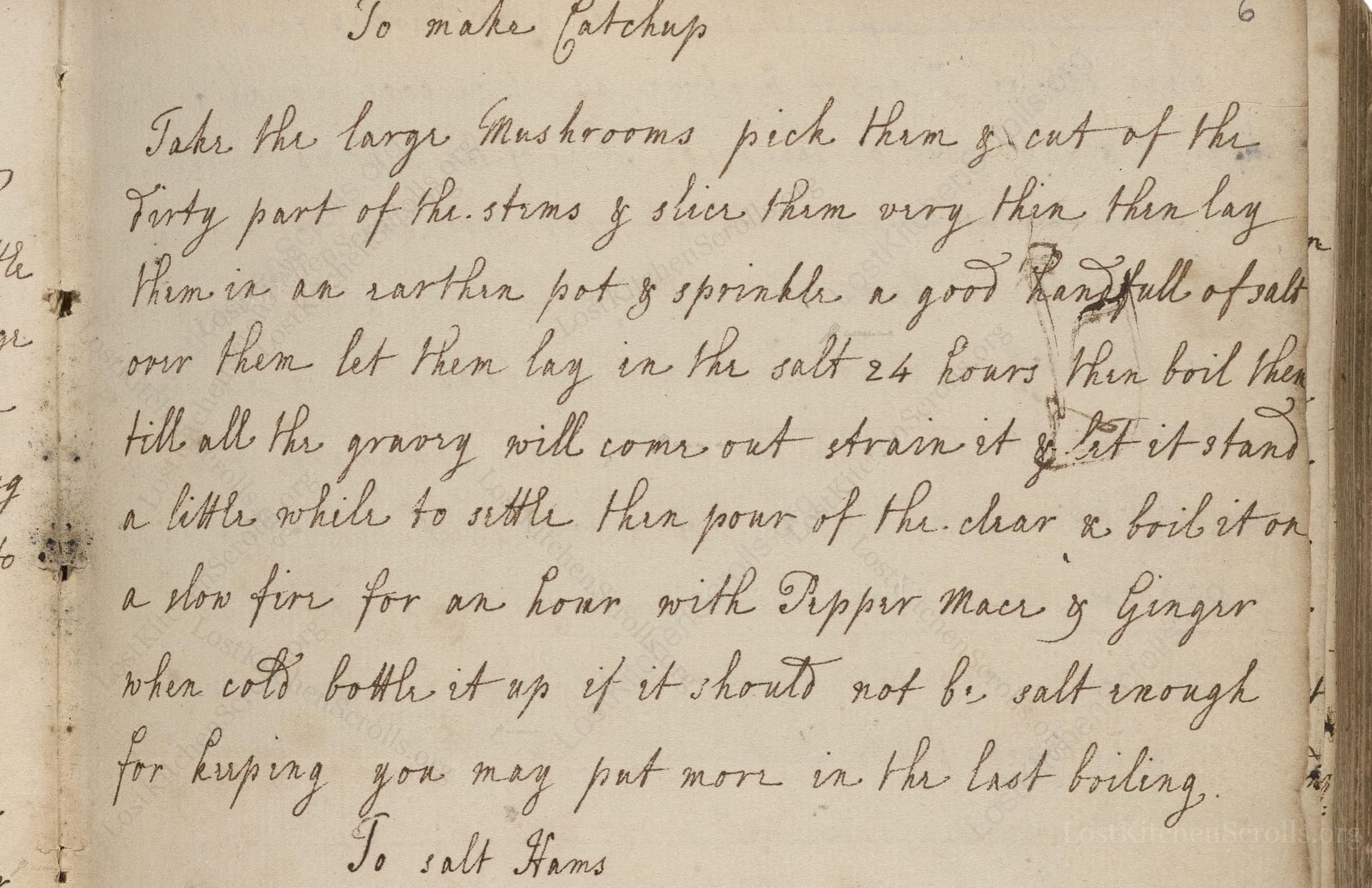To Make Catchup
From the treasured pages of Cookbook of Elizabeth Langley
Written by Elizabeth Langley

To Make Catchup
"Take the large Mushrooms pick them & cut of the Dirty part of the stems & slicer them very thin then lay them in an earthen pot & sprinkle a good Handfull of salt over them let them lay in the salt 24 hours then boil them till all the gravy will come out strain it & let it stand a little while to settle then pour of the clear & boil it on a slow fire for an hour with Pepper mace & Ginger when cold bottle it up if it should not be salt enough for keeping you may put more in the last boiling."
Note on the Original Text
The recipe is written in a direct, continuous prose style, typical for the mid-18th century: instructions are given in a sequence, often using verbs in the imperative. Spelling such as 'slicer' (for 'slice them'), 'gravy' (for mushroom juice), and 'mace' (the spice) are period usages. Recipes from this era assume the cook's knowledge and do not specify quantities—these were left to the judgment of the household cook, who would have been used to cooking by eye and taste.

Title
Cookbook of Elizabeth Langley (1757)
You can also click the book image above to peruse the original tome
Writer
Elizabeth Langley
Era
1757
Publisher
Unknown
Background
Step into the Georgian kitchen with Elizabeth Langley's 1757 culinary collection, where refined techniques and delightful recipes await those with a taste for historic gastronomy.
Kindly made available by
Folger Shakespeare Library
This recipe for 'Catchup' (or ketchup) dates from 1757 and was penned by Elizabeth Langley. In the 18th century, 'catchup' referred not to the tomato-based condiment we know today, but rather a savory, spiced mushroom sauce inspired by Eastern fermented sauces—which British cooks adapted for local tastes and ingredients. Homemade mushroom ketchup was a common and vital umami-rich seasoning long before tomatoes became popular for such sauces, offering deep, savory notes to gravies and stews. Recipes like this are a window into the resourceful, flavor-seeking kitchens of Georgian Britain.

In the 18th century, this catchup would have been made using basic but sturdy kitchen tools: an earthenware or stoneware pot for salting and soaking the mushrooms, a large iron or copper cauldron or saucepan for simmering, and muslin cloth or a fine sieve to strain the mushroom liquor. Liquids were always stored in glass or ceramic bottles, tightly corked to keep them fresh.
Prep Time
25 mins
Cook Time
1 hr 30 mins
Servings
20
We've done our best to adapt this historical recipe for modern kitchens, but some details may still need refinement. We warmly welcome feedback from fellow cooks and culinary historians — your insights support the entire community!
Ingredients
- 2 lbs large mushrooms (such as white or chestnut mushrooms)
- 1–1.25 oz sea salt (about 2–3 tbsp)
- 5–6 whole black peppercorns
- 2–3 blades mace (or substitute with 1/2 tsp ground mace)
- 1 piece fresh ginger (about 1 oz, sliced)
- Optional: extra salt to taste for preservation
Instructions
- Begin by selecting large, fresh mushrooms—button or flat mushrooms are both fine.
- Gently clean them, trimming away any soil or tough stem ends.
- Slice the mushrooms thinly and place them in a non-reactive bowl or ceramic pot.
- Sprinkle generously with coarse sea salt—about 2 to 3 tablespoons per 2 pounds of mushrooms.
- Mix well, cover, and let the mushrooms rest in the salt for about 24 hours to extract their juices.
- After 24 hours, transfer the mushrooms and the resulting brine to a large saucepan.
- Bring to a simmer over medium heat and cook gently for 20–30 minutes, allowing all the liquid (gravy) to seep out.
- Strain the mixture through a fine sieve or muslin cloth, collecting the clear juice.
- Let it sit briefly so any sediment can settle, then pour off the clear liquid into a clean saucepan, leaving any residue behind.
- Add whole peppercorns (about 1 teaspoon), a few blades of mace, and a thumb-sized piece of ginger (sliced).
- Simmer gently over low heat for 1 hour, reducing slightly.
- Taste for salt and add more if needed to ensure preservation.
- Cool completely before bottling in sterilized glass bottles.
- Seal and store in a cool place.
Estimated Calories
8 per serving
Cooking Estimates
The mushrooms need to sit in salt for a day, but actual hands-on prep and cooking time is short. You will spend about 25 minutes prepping and slicing the mushrooms, and about 1.5 hours cooking and simmering the liquid. This recipe makes about 20 standard (1 tablespoon) servings. Mushroom ketchup is low in calories because it is mostly a strained liquid from mushrooms and spices.
As noted above, we have made our best effort to translate and adapt this historical recipe for modern kitchens, taking into account ingredients nowadays, cooking techniques, measurements, and so on. However, historical recipes often contain assumptions that require interpretation.
We'd love for anyone to help improve these adaptations. Community contributions are highly welcome. If you have suggestions, corrections, or cooking tips based on your experience with this recipe, please share them below.
Join the Discussion
Rate This Recipe
Dietary Preference
Main Ingredients
Culinary Technique
Occasions

Den Bockfisch In Einer Fleisch Suppen Zu Kochen
This recipe hails from a German manuscript cookbook compiled in 1696, a time whe...

Die Grieß Nudlen Zumachen
This recipe comes from a rather mysterious manuscript cookbook, penned anonymous...

Ein Boudain
This recipe comes from an anonymous German-language manuscript cookbook from 169...

Ein Gesaltzen Citroni
This recipe, dating from 1696, comes from an extensive anonymous German cookbook...
Browse our complete collection of time-honored recipes



